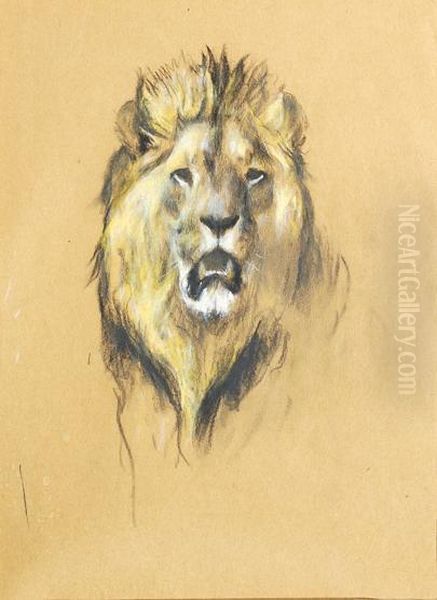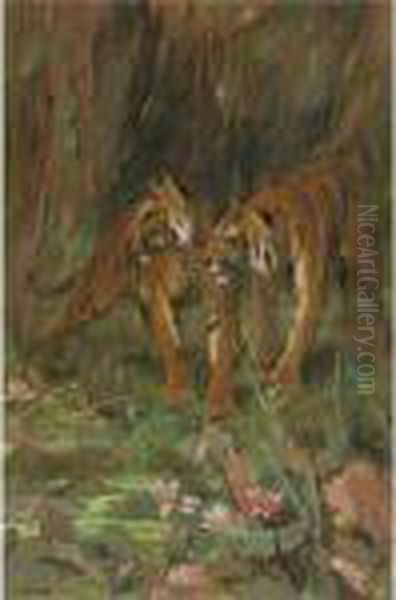Introduction: An Enduring Talent in British Art
Arthur Wardle stands as a significant figure in British art, particularly renowned for his exceptional ability to capture the essence of the animal kingdom. Active from the late Victorian era well into the mid-20th century, Wardle carved a unique niche for himself as a painter of animals, both domestic and wild. Born in London in 1864, he embarked on an artistic journey that spanned decades, leaving behind a prolific body of work celebrated for its naturalism, vitality, and technical skill. Unlike many of his contemporaries, Wardle's path to artistic mastery was unconventional, relying on innate talent and keen observation rather than formal academic training. His dedication to his craft resulted in a legacy that continues to be appreciated by art lovers and animal enthusiasts alike. He passed away in 1949, having established himself as one of Britain's foremost animal painters.
The Self-Taught Path to Mastery
One of the most remarkable aspects of Arthur Wardle's career is that he was entirely self-taught. In an era when academic training at institutions like the Royal Academy Schools was the conventional route for aspiring artists, Wardle honed his skills independently. He possessed a natural gift for observation and a deep affinity for animals, which he translated onto canvas and paper with increasing proficiency. His education came from direct study: observing animals in their natural environments, studying their anatomy, and capturing their movements. This reliance on empirical observation, rather than prescribed academic methods, likely contributed to the fresh, lifelike quality that distinguishes his work. His dedication to self-improvement through constant practice and study underscores his passion and determination.
Early Recognition: The Royal Academy Debut

Wardle's talent emerged early. At the remarkably young age of sixteen, in 1880, he achieved a significant milestone by having his first work accepted for exhibition at the prestigious Royal Academy of Arts in London. The painting, titled Cattle Study on the Banks of the Thames, signaled the beginning of a long and fruitful relationship with the institution. This early success was a testament to his burgeoning skills and his focus on animal subjects right from the outset of his professional career. Exhibiting at the Royal Academy was a critical step for any aspiring British artist, and Wardle's debut at such a young age marked him as a talent to watch. It was the first of many appearances; over his lifetime, he would exhibit well over one hundred works at the Royal Academy's summer exhibitions.
The Naturalist's Eye: Style and Approach
Arthur Wardle's artistic style is best characterized as naturalistic realism. He possessed an extraordinary ability to render animals with anatomical accuracy while simultaneously imbuing them with a sense of life and movement. His paintings go beyond mere photographic representation; they capture the spirit and characteristic behaviours of his subjects. Whether depicting the sleek power of a resting leopard, the alert stance of a terrier, or the gentle gaze of cattle, Wardle demonstrated a profound understanding of animal form and psychology. His brushwork, particularly in oils, was confident and descriptive, while his watercolours and pastels often displayed a lighter, more atmospheric touch. Central to his success was his commitment to direct observation, ensuring authenticity in every pose and expression.
Versatility in Mediums: Oil, Watercolour, and Pastel
Wardle was not confined to a single medium; he demonstrated exceptional skill across oils, watercolours, and pastels. While his large-scale oil paintings of wild animals are perhaps his most dramatic works, his watercolours possess a fluid grace, and his pastels showcase his ability to capture texture and light with subtlety. His proficiency in pastel was formally recognized in 1911 when he was elected a member of the Pastel Society. Later, in 1922, his skill in watercolour earned him election to the Royal Institute of Painters in Water Colours (RI). This versatility allowed him to adapt his technique to suit the subject and the desired mood, contributing to the breadth and richness of his oeuvre. Each medium offered different possibilities for capturing the diverse textures of fur, feather, and hide, as well as the interplay of light on form.
Canine Companions: Celebrating Man's Best Friend

Dogs were a recurring and beloved subject throughout Wardle's career. He gained particular renown for his portraits of terriers, especially Fox Terriers, which were immensely popular breeds during his time. His painting Totteridge XI (1897), commissioned by the famous Fox Terrier breeder Francis Redmond, is considered one of the definitive portraits of the breed, capturing the alert and intelligent nature of the dog. He also painted sporting dogs, such as in Brace of Setters on the Moor (1896), depicting them in their working environment with characteristic accuracy. Wardle's dog portraits were highly sought after by breeders and owners, valued for their lifelike quality and sympathetic portrayal. He successfully captured the individual personality of each animal, elevating dog portraiture beyond simple documentation.
The Call of the Wild: Exotic Animals and the London Zoo
While adept at painting domestic animals, Wardle possessed a particular fascination for wild and exotic creatures. The London Zoo became a vital source of inspiration and study for him. He spent considerable time there, sketching animals from life, capturing the power and majesty of big cats, elephants, and other non-native species. These sketches formed the basis for many of his most famous and dramatic compositions. Works such as A Leopard Resting (1891), Leopards Drinking (1892), Pool of Tigers (1897), Pumas and Macaws (1896), and Lions: Sunset (1913) showcase his ability to depict these magnificent animals with both accuracy and artistic flair. He seemed particularly drawn to the feline form, rendering lions, tigers, leopards, pumas, cheetahs (Cheetahs, 1913), and even snow leopards (Snow Leopards: Evening Crimson, 1921) with convincing realism and a sense of their inherent wildness.
Capturing the Drama of Nature
Wardle did not shy away from depicting the more dramatic aspects of the natural world. Some of his works capture moments of tension, hunt, or confrontation. A notable example often cited is a work depicting a tiger fighting a crocodile, showcasing his ability to handle complex compositions involving intense action and raw animal instinct. Paintings like Startled (c. 1890), showing tigers reacting in a dense jungle setting, or Pumas and Turkeys (1892), hinting at a predatory encounter, demonstrate his skill in creating narrative tension. These works highlight his understanding of animal behaviour and his capacity to convey the power dynamics inherent in the wild, moving beyond static portraiture into dynamic storytelling.
Beyond Pure Realism: Mythological and Literary Themes
While primarily known as an animal painter grounded in realism, Wardle occasionally explored mythological and literary themes, often incorporating animals into these narratives. His work Moon Kissed — Endymion draws inspiration from Greek mythology, likely depicting the shepherd Endymion beloved by the moon goddess Selene, possibly featuring animals within the pastoral or nocturnal scene. This willingness to engage with narrative subjects beyond pure animal studies demonstrates a broader artistic interest and adds another dimension to his body of work. It shows his ability to integrate his skill in animal depiction within wider imaginative contexts, connecting with classical traditions and storytelling.
A Prolific Exhibitor: Recognition at Home and Abroad

Arthur Wardle was a consistently active participant in the London art scene. His regular presence at the Royal Academy summer exhibitions, totalling over one hundred works throughout his career, ensured his visibility and cemented his reputation. Beyond the RA, his work was shown at other significant venues. A key moment was his first major solo exhibition, held at the Fine Art Society (often referred to as the Vicar's Gallery in some sources, though the Fine Art Society is more commonly cited for major artist shows) in 1935. His election to the Pastel Society and the Royal Institute of Painters in Water Colours further solidified his standing among his peers. His work was also included in international exhibitions, indicating recognition that extended beyond British shores.
Widespread Popularity and Enduring Legacy
Wardle achieved considerable popularity during his lifetime, extending far beyond the circles of fine art collectors. His appealing and expertly rendered images of animals struck a chord with the public. Consequently, his paintings were widely reproduced in various forms, including popular prints, postcards, calendars, cigarette cards, and even on packaging for items like chocolates. This commercial success, while sometimes viewed critically by the art establishment, speaks to the broad accessibility and appeal of his work. Today, his paintings are held in the collections of numerous public institutions, including the Victoria and Albert Museum (V&A), the Tate Britain, Leeds City Art Gallery, and the Dunedin Public Art Gallery in New Zealand, ensuring his artistic legacy endures.
Wardle in Context: The Victorian and Edwardian Art World
Arthur Wardle worked during a vibrant period in British art history. While he focused on animal painting, he exhibited alongside artists working in diverse styles and genres at the Royal Academy. His naturalistic approach can be seen in the context of late Victorian realism, though his specific focus set him apart. When considering animal painters, he inevitably invites comparison with the earlier titan of the genre, Sir Edwin Landseer (1802-1873). However, Wardle's work generally avoided the overt sentimentality and anthropomorphism often found in Landseer's paintings, favouring a more objective, though still dynamic, portrayal.
Contemporaries in Animal Painting
Within the specific field of animal painting, Wardle had several notable contemporaries. Briton Rivière (1840-1920) was another prominent painter of animals, often incorporating them into historical or narrative scenes with considerable dramatic effect. John Emms (1844-1912) was highly regarded for his depictions of dogs, particularly hounds, often capturing them with a vigorous, painterly style. Maud Earl (1864-1943), an exact contemporary by birth year, achieved international fame specifically for her lifelike and characterful dog portraits. John Trivett Nettleship (1841-1902) also specialized in wild animals, known for his powerful and sometimes unsettling depictions of animal life. Wardle's work stands alongside these artists, distinguished by its consistent naturalism and versatility across domestic and wild subjects.
The Broader Royal Academy Scene

Exhibiting frequently at the Royal Academy meant Wardle's work was shown alongside the leading figures of the late Victorian and Edwardian art establishment. These included proponents of High Victorian Classicism like Lord Frederic Leighton (1830-1896) and Sir Lawrence Alma-Tadema (1836-1912), former Pre-Raphaelites like Sir John Everett Millais (1829-1896), Symbolist-influenced painters like George Frederic Watts (1817-1904), and internationally acclaimed portraitists like John Singer Sargent (1856-1925). While Wardle's subject matter differed significantly, his technical proficiency and consistent presence placed him within this prominent artistic milieu. His participation in societies like the RI also connected him with watercolour specialists such as Helen Allingham (1848-1926), known for her charming rural scenes.
Later Life and Lasting Contribution
Arthur Wardle spent much of his life and career based in London, residing in areas such as St John's Wood at various points. He continued to paint prolifically throughout his later years, maintaining his high standards of execution and his dedication to animal subjects. His success allowed him a comfortable life dedicated to his art. When he died in 1949, he left behind a substantial legacy as one of Britain's most accomplished and popular animal painters. His self-driven path to success, his technical mastery across different mediums, and his ability to capture the vitality and essence of animals ensure his enduring place in the history of British art. His work remains a testament to the power of observation and a deep connection with the natural world.